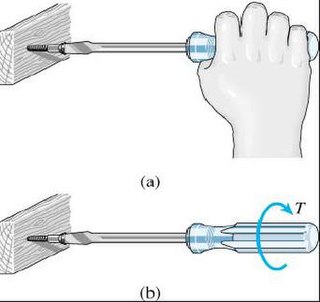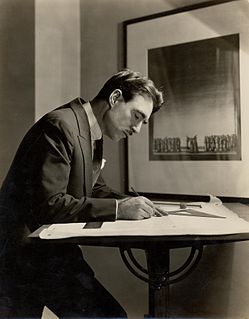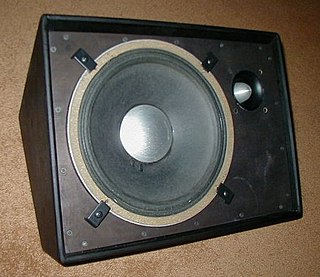
A reed is a thin strip of material which vibrates to produce a sound on a musical instrument. The reeds of most woodwind instruments are made from Arundo donax or synthetic material; tuned reeds are made of metal or synthetics. Musical instruments may be classified according to the type and number of reeds used.

A theatre lighting designer works with the director, choreographer, set designer, costume designer, and sound designer to create the lighting, atmosphere, and time of day for the production in response to the text, while keeping in mind issues of visibility, safety, and cost. The LD also works closely with the stage manager or show control programming, if show control systems are used in that production. Outside stage lighting, the job of a Lighting Designer can be much more diverse and they can be found working on rock and pop tours, corporate launches, art installation and on massive celebration spectaculars, for example the Olympic Games opening and closing ceremonies.

Usability is the ease of use and learnability of a human-made object such as a tool or device. In software engineering, usability is the degree to which a software can be used by specified consumers to achieve quantified objectives with effectiveness, efficiency, and satisfaction in a quantified context of use.

Stagecraft is the technical aspect of theatrical, film, and video production. It includes constructing and rigging scenery; hanging and focusing of lighting; design and procurement of costumes; make-up; stage management; audio engineering; and procurement of props. Stagecraft is distinct from the wider umbrella term of scenography. Considered a technical rather than an artistic field, it is primarily the practical implementation of a scenic designer's artistic vision.
Electrical lighting technicians (ELT) or simply lighting tech., are involved with rigging stage and location sets and controlling artificial, electric lights for art and entertainment venues or in video, television, or film production.

A preschool, also known as nursery school, pre-primary school, playschool or kindergarten, is an educational establishment or learning space offering early childhood education to children before they begin compulsory education at primary school. It may be publicly or privately operated, and may be subsidized from public funds.

A pit orchestra is a type of orchestra that accompanies performers in musicals, operas, ballets, and other shows involving music. The terms was also used for orchestras accompanying silent movies when more than a piano was used. In performances of operas and ballets, the pit orchestra is typically similar in size to a symphony orchestra, though it may contain smaller string and brass sections, depending upon the piece. Such orchestras may vary in size from approximately 30 musicians to as many as 90–100 musicians. However, because of financial, space, and volume concerns, the musical theatre pit orchestra in the 2000s is considerably smaller.

A rehearsal is an activity in the performing arts that occurs as preparation for a performance in music, theatre, dance and related arts, such as opera, musical theatre and film production. It is undertaken as a form of practising, to ensure that all details of the subsequent performance are adequately prepared and coordinated. The term "rehearsal" typically refers to ensemble activities undertaken by a group of people. For example, when a musician is preparing a piano concerto in their music studio, this is called "practicing", but when they practice the concerto with an orchestra, this is called a "rehearsal". The music rehearsal takes place in a music rehearsal space.

Hard and soft light are different types of lighting that are commonly used in photography and filmmaking. Soft light refers to light that tends to "wrap" around objects, casting diffuse shadows with soft edges. Soft light is when a light source is large relative to the subject; hard light is when the light source is small relative to the subject.

A Fresnel lantern is a common lantern used in theatre, which employs a Fresnel lens to wash light over an area of the stage. The lens produces a wider, soft-edged beam of light, which is commonly used for back light and top light.

Stage lighting instruments are used in stage lighting to illuminate theatrical productions, concerts, and other performances taking place in live performance venues. They are also used to light television studios and sound stages.
A theatrical technician, is a person who operates technical equipment and systems in the performing arts and entertainment industry. In contrast to performers, this broad category contains all "unseen" theatrical personnel who practice stagecraft and are responsible for the logistic and production-related aspects of a performance including designers, operators, and supervisors. Many professional designers and technicians consider the diminutive "techie" to be offensive.
In theater, a rider is a set of requests or demands that a performer sets as criteria for performance. Types of riders include hospitality and technical.
A light plot, lighting plot or just plot is a document like an architectural blueprint used specifically by theatrical lighting designers to illustrate and communicate the lighting design to the director, other designers and finally the Master Electrician and electrics crew. The light plot specifies how each lighting instrument should be hung, focused, colored, and connected. Typically the light plot is supplemented by other paperwork such as the channel hookup or instrument schedule.

Live sound mixing is the blending of multiple sound sources by an audio engineer using a mixing console or software. Sounds that are mixed include those from instruments and voices which are picked up by microphones and pre-recorded material, such as songs on CD or a digital audio player. Individual sources are typically equalised to adjust the bass and treble response and routed to effect processors to ultimately be amplified and reproduced via a loudspeaker system. The live sound engineer listens and balances the various audio sources in a way that best suits the needs of the event.
Often task lighting refers to increasing illuminance to better accomplish a specific activity. However, the illuminance level is not the only factor governing visibility. Contrast is also important, and a poorly positioned light source may cause contrast reduction, resulting in loss of visibility. The most important purpose of task lighting in the office is not increasing illuminance, but improving contrast. General lighting can be reduced because task lighting provides focused light where needed.

A stage monitor system is performer-facing loudspeakers known as monitor speakers or stage monitors on stage during live music performances in which a PA system or sound reinforcement system is used to amplify the performers' singing, music, speech and other sounds for the audience. In Britain the term foldback is often used to describe the system. Monitor speakers are useful when amplified instruments are used with acoustic instruments and voice. Monitor speakers often include a single full-range loudspeaker and a horn in a cabinet. Monitor speakers have numerous features which facilitate their transportation and protection, including handles, metal corner protectors, sturdy felt covering or paint and a metal grille to protect the speaker. There are two types of monitors: passive monitors consist of a loudspeaker and horn in a cabinet ; active monitors have a loudspeaker, horn and a power amplifier in a single cabinet, which means the signal from the mixing board can be plugged straight into the monitor speaker.

Offstage musicians and singers are performers who play instruments and/or sing backstage, out of sight of the audience, during a live popular music concert at which the main band is visible playing and singing onstage. The sound from the offstage musicians or singers is captured by a microphone or from the output of their instrument, and this signal is mixed in with the singing and playing of the onstage performers using an audio console and a sound reinforcement system. Offstage backup singers are also used in some Broadway musicals, as have offstage instrumentalists, in cases where an onstage actor needs to appear to play an instrument.













